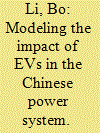|
|
|
Sort Order |
|
|
|
Items / Page
|
|
|
|
|
|
|
| Srl | Item |
| 1 |
ID:
191114


|
|
|
|
|
| Summary/Abstract |
This paper reviews progress towards the establishment of an Association of Southeast Asian Nations (ASEAN) Power Grid (APG) and the key barriers to multilateral cross-border electricity trade in ASEAN. An analysis across political, technical, institutional, economic, environmental, social and time dimensions is employed. Using a policy sequencing framework, the paper concludes it remains premature for ASEAN to pursue a strong form of power sector market integration on account of the sizeable barriers that currently remain, especially economic and institutional barriers. Focusing on bilateral power purchase agreements and large-scale investments in solar and wind power over 2022–2030 would help to develop stronger foundations for ASEAN to make steps towards deeper regional integration in the electricity sector in subsequent years, while also being consistent with renewables adoption goals.
|
|
|
|
|
|
|
|
|
|
|
|
|
|
|
|
| 2 |
ID:
177312


|
|
|
|
|
| Summary/Abstract |
The deployment of renewable electricity and electric vehicles (EVs) provides a synergistic opportunity to accelerate the decarbonization of both China's power and transportation sectors. Here, we evaluate the potential impacts of EVs by utilizing the SWITCH-China model designed to meet emissions constraints within its power sector while integrating the electrified transportation sector. We focus on how various EV stocks, and charging strategies (unmanaged versus smart charging) impact the power sector, in terms of generation and hourly grid operation, the capacity mix, and achieving the Paris Agreement goals. Large-scale deployment of EVs increases the need for generation capacity, while the implementation of smart charging requires 6.8%–14% less additional storage capacity. We calculate that power system integration costs to incorporate EVs range from $228 - $352 per EV. We show that a smart charging strategy saves between $43 and $123 per vehicle more annually in 2050 than a case with the same EV stock where the charging is unmanaged. Our results suggest that a 140 GW annual growth of renewables from 2020 to 2050, coupled with an aggressive EVs deployment using smart charging can put China solidly on a path to meet its ambitious carbon cap targets.
|
|
|
|
|
|
|
|
|
|
|
|
|
|
|
|
| 3 |
ID:
114310


|
|
|
|
|
| Publication |
2012.
|
| Summary/Abstract |
Many of the scenarios for decarbonising the European energy system involve the integration of large-scale and decentralised renewable energy sources, such as wind and solar power. However, such integration requires substantial and rapid improvements to the existing transmission grids. Using a mix of qualitative and quantitative methods, we analysed the opinions and views of stakeholders concerning the main barriers and solutions to this problem. The results suggest two conclusions. The first is that primary barriers to the currently needed level of grid expansion are not technical or financial, but the lack of appropriate regulatory frameworks and public acceptance. The second is that major changes are needed in the overall regulatory process, rather than simply minor modifications or improved implementation of existing regulations.
|
|
|
|
|
|
|
|
|
|
|
|
|
|
|
|
| 4 |
ID:
150919


|
|
|
|
|
| Summary/Abstract |
Studying temporal patterns in emissions associated with electricity generation is increasingly important. On the supply side, there is interest in integrating renewable energy sources (solar, wind), which are known to vary daily and hourly. On the demand side, the concept of demand response is driving a need to better understand the impact of peak versus off-peak loading, with the objective of maximizing efficiency. In this study, we examine the case of electric power generation in Singapore, and aim to assess the half-hourly variation in associated average carbon dioxide emissions. Given the country’s serious push for clean energy solutions and a possibility of adopting carbon trading in the future, we feel the need to address the currently existing gap in research on daily CO2 emissions patterns. By associating representative electricity generation data with the characterized fleet of power plants, half-hourly emissions are found to range between 415 and 455 kg CO2 per MW h. Marginal emission factors show a fluctuating daily pattern between 390 and 800 kg CO2/MW h. Policy makers able to work with real generation data can use this approach to understand the carbon footprint of short-term supply and demand interventions.
|
|
|
|
|
|
|
|
|
|
|
|
|
|
|
|
| 5 |
ID:
174991


|
|
|
|
|
| Summary/Abstract |
To increase acceptance and reduce opposition towards power grid expansion, various opportunities for citizen participation have been implemented within grid-expansion-related planning procedures. Previous studies have found that residents' participation can lead to an increase in acceptance and a reduction in conflict, particularly if the participation processes are perceived as fair and just. A question that has not been answered sufficiently so far, however, is why residents participate in information and participation measures offered throughout the planning process of transmission line projects. This question is addressed in the present study. On the basis of the ‘Civic Voluntarism Model’, this study derives research propositions on potential determinants of participation and empirically tests them by drawing on data collected from residents in two German regions affected by grid expansion. The results show that specific resources available to residents, psychological motivation factors, and recruiting social networks can significantly influence the probability of participation. Since the studies in both regions arrived at very similar results, the findings possess a high degree of external validity. Overall, the study presents novel insights into the mechanisms of citizen participation in power grid planning and provides policymakers, regulators, and transmission system operators with relevant practical knowledge.
|
|
|
|
|
|
|
|
|
|
|
|
|
|
|
|
|
|
|
|
|